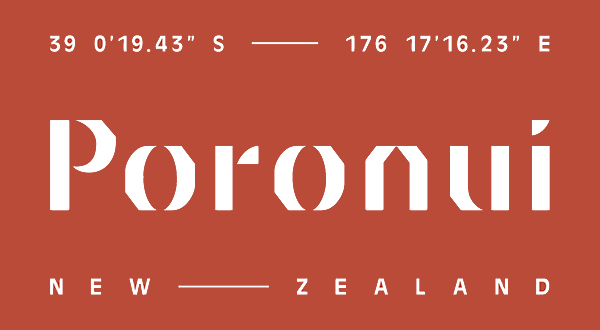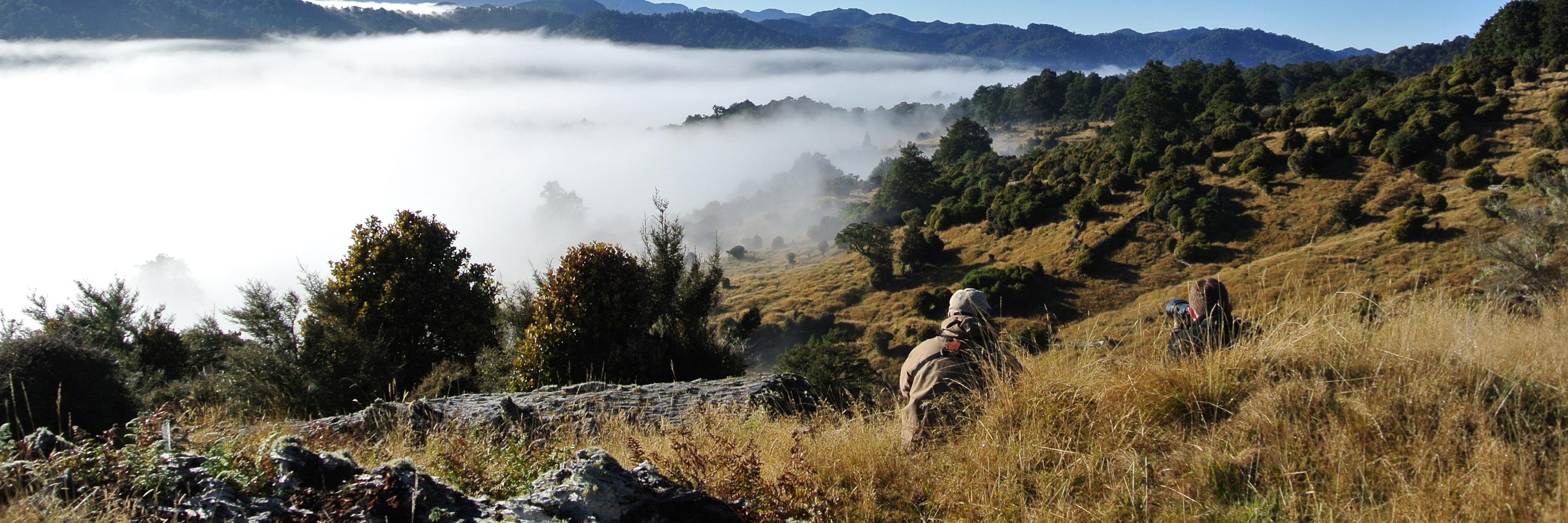The Velvet & Trophy Production of Poronui Sika Stags
One of the great things about this study is that it has given me the chance to visit Poronui two or three times a month, twelve months of the year, including three consecutive summers now. I keep a diary of the deer I see each trip, recording the numbers of individual age and sex classes of deer I observe as separate entries, as follows:
- hinds;
- fawns/weaners;
- stags; and
- 8-pointers.
Over the past thirty months, this has built into a very interesting data-set. On average I see 23 deer per trip (range 7 to 63), but the make-up of the four age and sex classes (above) observed each time varies enormously, depending on the time of year. Of most interest to sika trophy hunters are the stag counts and antler/velvet observations I have recorded. These provide a wonderful insight into velvet and trophy production. Perhaps even more significantly, they provide an indication of the importance of Poronui as an ‘engine-room’ for sika trophy production, over a large part of the Central North Island landscape.
Not unexpectedly, the numbers of hind observations in my diary is very low from late November well into summer. Most mature hinds have retreated to the seclusion of their ‘manuka maternity wards’ by this time and tend to stay reasonably well hidden until at least late January. The total proportion of hinds (and fawns) observed in my trip tallies increases dramatically through February and March but is very low through December and January.
One of our collared stags captured on game camera in December 2011 with a couple of good sticks of velvet up (Photo courtesy of Poronui).
Stags on the other hand have made up most of my observations through December and January, especially this year. Since Poronui implemented a Quality Deer Management approach on the property in 2008, the age structure of the stag population has shifted significantly. The focus on maintaining lower hind numbers and proactively protecting young stags has resulted in larger and larger bachelor groups year on year, for four years now. This has allowed for a greater proportion of stags in the population and, most importantly from a trophy hunting perspective, more stags reaching 3 and 4 years old.
Young velvet stag groups of twelve or more individuals are now commonplace on Poronui, with seasonal groupings of 30+. Big mature stags (usually 8 pointers) tend to remain in smaller groups or even alone but they will congregate from November through February on certain parts of the property in very large, loose groups to feed on the best pick. Come mid to late March, these stags vanish to all points of the compass. Our study shows they move 4 to 15 kilometres for about 8 to 10 weeks for the rut, before returning in early June to the same locations they occupied in February. It is very uncommon to see groups of stags in April/May. Most stags recorded in my diary during the rut are seen alone or with hinds/fawns, but stags group up again in June when the largest mobs are observed.
The other observation that has struck me from three summers of careful scrutiny of the Poronui sika herd is the annual variation in velvet production. The timing and quality of velvet production at Poronui is incredibly inconsistent each year. I believe velvet production is linked to a number of highly variable seasonal factors including:
The severity of the previous winter (stags that come out of winter in good condition grow better velvet);Spring and summer moisture levels (the pumice terrace soils at Poronui are prone to drying out and the quality of nutrition is linked to seasonal/annual rainfall patterns): andAvailable forage – Poronui has experimented with a range of crops (oats, clover, lotus, etc) together with habitat manipulation in the past three years, which have hugely influenced deer diet and performance.
These variables, in different combinations each year, account for variations in the performance of velvet production in the local herd. They closely mirror observations hunters might have noted in the hard antler that has been on display annually at the Taupo Sika Show over many years as well, where the overall quality of antlers has been very different each year.
There is always regional variation in quality, reflecting the wide geographical influences this herd is subject to. However, I believe more general climatic patterns play a huge role too. The La Nina and El Nino climatic effects are a good example. These very different weather patterns can affect different parts of the sika range in quite unique ways.
At Poronui, the regular moisture spill over from Hawkes Bay rain in a typical easterly La Nina pattern is a key indicator of good trophy production, while it may be an indicator of poorer velvet growth further west in the rain shadow effect of the Kaweka and Kaimanawa Mountains. The great Poronui velvet production over the past two years has been helped by this La Nina effect. The fact that there are more stags now and that they are getting older, only makes for better outcomes.
The contrast is the typical westerly El Nino effect that dries out the pumice terrace soils at Poronui, but may allow for better velvet production further west where Mount Ruapehu traps much of the rain. If high summer at Poronui is brown and the beech forests end up like ‘crispy cornflakes’ under El Nino summer drought, no matter how well the spring growth started, the length and tops of “trophies” often fade.
A very nice ~ 30 inch Poronui sika stag captured in February 2012. This stag was seen within 200m of this location during February 2011. Only he knows where he goes to rut but our data suggests it will be somewhere between 4 and 15 kilometres of the location in this photo. No-one got him last year – will anyone get him this year? If he does survive, he will be safe on Poronui next spring/summer to ensure he remains available for some lucky trophy hunter next year (Photo – Murray Cleaver).
Because the velvet growing process takes about 90 days, usually starting in sika through October/November and finishing in early February, its easy for the ‘wheels’ to fall off a velvet season that might start well. Great brow tines can turn into nothing flash if its too dry, just as poor brow tines might turn into good length and great tops if December/January rains allow. The point is – every year is different.
Thankfully this year was another (though mild) La Nina. If you hunt in the Kaipo, Tikitiki, Oamaru, Otupua or Wharetoto (and perhaps even a little further afield?) you can expect a good roar this year with plenty of fine, fat, well grown out young (3 and 4 year old) sika stags on offer – all courtesy of the good growing conditions; the spring/summer protection; and quality feed available on Poronui. Our research may not have been the cause of your success this roar, but it sure will help you understand why you might enjoy greater success in these areas than you may have previously.
If you do see one of our collared stags in your roar travels this year, we accept that it is your right to harvest him. But we would be grateful if you would consider passing up the opportunity to shoot a collared animal or could at least return the collar with a location of the harvest if you do. Even better still, if you send us a photo of a live collared stag, we’ll take you out radio-tracking for a day – you might be amazed at what you could learn.
One final note: Some of this information may make it seem very attractive to poach on properties like Poronui but in doing so, please realise that doing so would be very much a case of killing the goose that lays the golden egg. Poronui have been incredibly generous with their management approach; their access for the study; and their allowing so much valuable sika management information to be released into the public arena through articles like this one. Hunters should respect private land and recognise that they get significant benefit from the deer management programme on Poronui. Poaching is not in anyone’s interest except the greedy, selfish few – who could ruin it for everyone.
Check out www.camspeedy.co.nz for contact details if you would like to help our project. You can also down load PDFs of project updates; home range maps of collared stags; photos; and view our Project Video – there is some great sika footage to be enjoyed.
The radio tracking study of sika deer in the Taharua Valley of the Central North Island has been ongoing since September 2009, thanks to the valued contributions of Poronui New Zealand; Hunters & Habitats Inc.; the Sika Show Taupo Ltd; NZ Outdoor Hunting Magazine; AJ Productions and a range of other generous supporters.
- Sika: a balanced trophy
- Black fallow bucks of Poronui
- Hunting Pheasants on Poronui
- Red Stag Rut Peak
- Horn trophies: Arapawa rams
- Poronui recipe series: Winter Venison Stew Pie
- The red stag roar
- What to look for in a New Zealand hunting destination
- Trophy fallow bucks in the cutover
- Conducting an ambush
Want to ask a question about Poronui, personalise your vacation with bespoke itinerary options or find out about available dates? We would love to hear from you!
Simply fill in your name and contact email address with a short message and we will get back to you.


